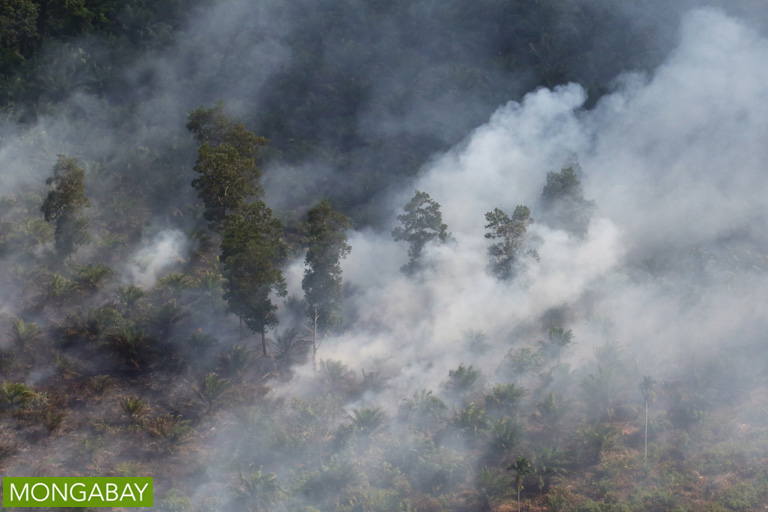- In late 2015, Indonesia featured heavily in the global headlines.
- Between June and November 2015, Indonesia experienced one of its worst fire and haze episodes ever.
- Impressively, during 12 days in Kalimantan with plenty of hot clear days, I saw exactly one small fire. Something seemed to be different.
- This post is a commentary — the views expressed are those of the author.
In late 2015, Indonesia featured heavily in the global headlines. Parts of the country were burning so badly that the fires were coined “the greatest environmental disaster of the 21st century”. Indonesia’s neighbors Malaysia and Singapore were complaining vociferously and clearly large parts of the South-East Asian region were suffering.
Between June and November 2015, Indonesia experienced one of its worst fire and haze episodes ever. The most recent estimates indicate that some 116,000 individual fires burned up to 6.5 million acres of scrub and forest land in 2015. Air quality during high burning periods in villages near the fires regularly exceeded the maximum level of 1000 on the international Pollutant Standard Index (PSI)—this is more than three times the amount considered “hazardous.” In the wider region, some 110 million people were affected by the haze.
The World Bank estimated that the total economic costs of the fires in 2015 in Indonesia exceeded US $16 billion. This estimate is more than double the damage and losses from the 2004 tsunami, and equal to about 1.8% of Indonesia’s Gross Domestic Product.
The societal and economic impact figures from the fires clearly drew the attention of the Indonesian government. Indonesian fires are nothing new though, and several Indonesian presidents have spoken out about fighting them. So far, none have successfully stopped this annual curse. Indonesian fires are nearly all man-made. People burn land to open it up for agriculture, or to claim it for speculation on future land deals. Such burning has been illegal for years. Obviously, law enforcement was not working.

I was talking a few months ago to Dr. Hadi Daryanto, the Director General of Social Forestry in the Indonesian Ministry of Environment and Forestry. He explained why Indonesia has so far been unsuccessful in preventing major fire events. “First”, he said, “there is insufficient government funding to prevent fires. Second, fire prevention is not a priority for local-level government at the province or district level. And third, local elites benefit from using fires in land speculation.” He suggested that this time, however, there was going to be real change in Indonesia’s management of fires. I thought that sounded pretty promising”.
On a recent trip to Central Kalimantan, I decided to check out what was going on. Impressively, during 12 days in Kalimantan with plenty of hot clear days, I saw exactly one small fire. On clear dry days when normally skies would turn hazy and several smoke plumes would be visible, now all was a fresh blue. Something seemed to be different.
Local government officials explained what was now different compared to previous years. Mr Muriansyah, the head of a local forestry police unit, told me that “every responsible person in government now has real-time information on their phones about the location of fire hotspots, which are detected by satellite”. He further explained that through direct instruction from the President and the Minister of Environment and Forestry, every detected fire now requires an immediate response from a team of army, police, forestry guards, and fire fighters. Apparently several people, who had been caught by such teams near a fire, had already been prosecuted and sentenced to jail terms or fined.
Probably most importantly, however, as explained by the Head of the Forestry and Agriculture office in the East Kotawaringin District, there is a threat that every senior army, police, or local government official who has fires in their area will be demoted. If that indeed happens, this would be a powerful means to reduce fires, because careers are at stake.

One thing I was worried about is what local people might think. Many people use fire for small-scale agriculture. How are they supposed to clear land without access to land clearing equipment? Interestingly, a few discussions I had with traditional farmers suggested that they were not too concerned. Mr. Arifin, a local farmer in the inland town of Pahirangan, explained that they were ok with and well-informed about the new government regulations. “Instead of burning the land in May, at the start of the dry season”, he said, “I will now have to clear land a few months earlier, allowing the vegetation to decompose and turn into good soil”. “It is not a problem”.
It is too early to say whether Indonesia’s present efforts to prevent future fire disasters will succeed. Looking at fire risk maps of the region, the land is now becoming quite fire prone, but there are only a handful of fires in Kalimantan.
Whatever the outcome, this is a promising and important initiative from Indonesia. I hope that the Indonesian government gets the local support and help from the international community to further support the country in resolving its burning issue.

Erik Meijaard coordinates the Borneo Futures initiative. Follow him on Twitter at emeijaard.
